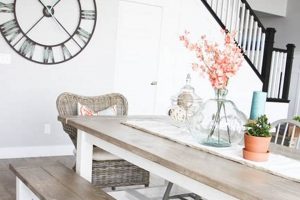A manufactured wood panel product utilizing multiple layers of thin wood veneers bonded together with adhesive, it serves as a foundational material for crafting personalized furniture pieces. Its construction, characterized by alternating grain direction in each layer, imparts significant strength and dimensional stability, making it a popular choice for surfaces requiring durability and resistance to warping. For instance, its flat, rigid nature provides an excellent substrate for constructing a dining or work surface.
The utilization of this engineered wood offers several advantages in furniture construction. Its cost-effectiveness compared to solid wood is notable, as is its availability in large sheets, simplifying the creation of wide surfaces. Furthermore, the inherent stability minimizes the risk of cracking or splitting, contributing to the longevity of the finished item. Historically, the material has been valued for its balance of strength, workability, and affordability, leading to its widespread adoption in numerous applications beyond just table construction.
The subsequent sections will detail specific grades appropriate for furniture making, outline cutting and joining techniques, discuss finishing options to enhance both aesthetics and longevity, and address common challenges encountered during the construction process. This exploration aims to provide a comprehensive understanding of its application, enabling the successful creation of robust and visually appealing furniture.
Essential Considerations for Plywood Application in Table Construction
The following guidelines offer practical advice for achieving optimal results when utilizing engineered wood panels in creating personalized tables. Adherence to these principles will enhance the structural integrity and aesthetic appeal of the finished project.
Tip 1: Grade Selection is Paramount: Opt for cabinet-grade panels, characterized by smooth, void-free surfaces. This minimizes the need for extensive filling and sanding prior to finishing, resulting in a more professional appearance.
Tip 2: Proper Sealing is Crucial: Thoroughly seal all edges and surfaces, especially end grain, with a suitable edge banding, primer, or sealant. This prevents moisture absorption, which can lead to warping and delamination over time.
Tip 3: Joint Strength Requires Precision: Employ robust joinery techniques, such as pocket screws, dowels, or mortise and tenon joints, to ensure structural stability. Weak joints compromise the table’s ability to withstand everyday use.
Tip 4: Surface Preparation is Key: Sand the surface meticulously, progressing through progressively finer grits of sandpaper. A smooth, even surface is essential for achieving a flawless finish, whether painting, staining, or applying a clear coat.
Tip 5: Consider a Support Structure: Integrate a robust support frame or apron underneath the tabletop to prevent sagging, particularly for larger surfaces. This distributes weight evenly and enhances overall stability.
Tip 6: Accurate Cutting for Precise Assembly: Ensure cuts are accurate and square, using a table saw or circular saw with a guide. Inaccurate cuts lead to gaps and misalignments during assembly, affecting the structural integrity and appearance.
Tip 7: Pilot Holes Prevent Splitting: Always drill pilot holes before driving screws, especially near the edges. This prevents the material from splitting and ensures a secure, long-lasting connection.
By carefully considering the grade of the wood panels used, implementing proper sealing and joinery techniques, and focusing on meticulous surface preparation, a durable and aesthetically pleasing table can be constructed. These practices will enhance the furniture piece’s longevity and contribute to a professional final product.
The subsequent section will delve into specific design considerations and finishing techniques to further elevate the quality and appearance of the finished table.
1. Grade Selection
Grade selection is a critical determinant of the final quality and suitability of a manufactured wood panel table. The grade directly impacts the aesthetic properties, structural integrity, and workability of the material, influencing the effort required for finishing and the long-term durability of the furniture piece.
- A-Grade Veneer: Superior Aesthetic Quality
A-grade veneers represent the highest quality available. They are characterized by a smooth, blemish-free surface, minimal knots, and a consistent grain pattern. While more expensive, A-grade panels require minimal preparation before finishing and are ideal for applications where visual appeal is paramount. Using A-grade panels is advantageous when creating high-end tables where the wood grain is intended to be a focal point of the design.
- B-Grade Veneer: Balance of Quality and Cost
B-grade veneers possess minor imperfections, such as small knots or slight discoloration, which may necessitate some filling and sanding prior to finishing. These panels offer a more economical option while still providing a relatively smooth surface suitable for painting or staining. B-grade is often chosen when cost is a significant factor, and the design incorporates opaque finishes that conceal any minor surface defects.
- C- and D-Grade Veneers: Utility and Structural Applications
C- and D-grade veneers exhibit more pronounced defects, including large knots, open voids, and inconsistent grain patterns. These grades are generally not suitable for exposed surfaces in table construction. Their primary applications lie in structural components, such as internal bracing or hidden supports, where aesthetic considerations are secondary to strength and cost-effectiveness. Using these grades for table tops typically requires extensive patching and may compromise the overall stability.
- Cabinet-Grade: Ideal for Furniture Construction
Cabinet-grade is a designation that usually indicates A or B grade faces (and backs) over a stable core. This offers the best combination of surface quality and structural soundness. This material will be relatively free of voids in the inner plies, also, giving better screw holding power along edges. It offers a good balance for those seeking furniture grade panels.
The appropriate grade selection directly influences the required finishing techniques, material cost, and the ultimate longevity of the finished table. Choosing a lower grade may initially seem cost-effective but can lead to increased labor and material expenses during the finishing process, potentially compromising the structural integrity of the finished product. Therefore, an informed decision regarding the optimal grade, balancing aesthetic requirements with budgetary constraints and structural considerations, is fundamental to successful project execution.
2. Thickness Options
The selection of appropriate thickness is a critical determinant in the design and construction of tables utilizing manufactured wood panels. The chosen thickness directly influences the table’s structural integrity, load-bearing capacity, and overall aesthetic proportions. Insufficient thickness can lead to sagging or failure under load, while excessive thickness may result in unnecessary weight and material cost. The intended use of the table and the anticipated load it will bear must be carefully considered when determining the necessary thickness. For example, a small side table intended for light use may require a thinner panel than a large dining table expected to support significant weight. Common thicknesses range from 1/4 inch to over 1 inch, each offering varying degrees of strength and rigidity.
The span between supporting structures also dictates the required thickness. A table with widely spaced legs will necessitate a thicker panel to prevent deflection than a table with a closely spaced apron or center support. Furthermore, the joinery methods employed influence the optimal thickness; robust joinery techniques, such as mortise and tenon or reinforced pocket screws, can distribute stress more effectively, potentially allowing for a slightly thinner panel. The aesthetic considerations also play a role: a thicker edge profile may be desired for visual impact, while a thinner profile can create a more minimalist appearance. Achieving the correct balance between structural requirements and aesthetic preferences is paramount.
In summary, the selection of thickness is a multifaceted decision involving structural analysis, aesthetic judgment, and a thorough understanding of the intended application. Overlooking this critical aspect can lead to structural failure or a visually unappealing result. Proper evaluation of load requirements, span distances, and design preferences ensures the selection of a thickness that provides adequate strength, stability, and aesthetic harmony. This decision affects both the initial cost and the long-term performance of the table, making it a fundamental consideration in the design process.
3. Edge Treatment
Edge treatment is a crucial aspect of constructing tables using manufactured wood panels, significantly influencing both the aesthetic quality and structural integrity of the finished piece. Raw edges expose the layered construction, creating an unfinished appearance and potentially compromising resistance to moisture intrusion. Therefore, selecting and applying appropriate edge treatments are essential for producing a durable and visually appealing table.
- Iron-On Edge Banding: Cost-Effective and Simple Application
Iron-on edge banding, typically made of PVC or wood veneer, offers a readily available and relatively inexpensive method for covering exposed edges. Application involves using heat from a household iron to melt the adhesive backing and bond the banding to the substrate. While simple to apply, iron-on edge banding may be less durable than other options and can be susceptible to peeling or chipping with heavy use. This method is generally suitable for smaller projects or tables that will not be subjected to significant wear and tear.
- Solid Wood Edge Banding: Enhanced Durability and Aesthetic Appeal
Solid wood edge banding involves attaching strips of solid wood to the edges of the manufactured wood panel. This method offers increased durability and allows for shaping or profiling the edges to create a more refined appearance. Attachment can be achieved using glue and clamps, or with more advanced joinery techniques such as biscuits or dowels. Solid wood edge banding provides a seamless transition from the table surface to the edge, enhancing the overall aesthetic and perceived value of the piece. This method is suitable for higher-end projects where durability and visual appeal are prioritized.
- Veneer Edge Banding: Balancing Cost and Aesthetics
Veneer edge banding offers a compromise between the affordability of iron-on banding and the durability of solid wood. This involves applying thin strips of wood veneer to the edges using adhesive and clamps. Veneer edge banding provides a more professional appearance than iron-on options and can be stained or finished to match the table surface. While less durable than solid wood, veneer edge banding offers a cost-effective solution for achieving a refined edge detail without the expense or complexity of solid wood joinery.
- Filler and Paint/Epoxy: Seamless and Customizable Finish
This approach involves filling the exposed edges with wood filler or epoxy to create a smooth, paintable surface. This method provides a seamless look, as the filler can be sanded flush with the panel surface and painted to match the rest of the table. Epoxy offers greater durability and water resistance compared to wood filler. This edge treatment allows for a high degree of customization, enabling the creation of unique edge profiles and decorative effects. It’s a good choice for painted tables or when seeking a perfectly smooth and even edge.
The selection of an appropriate edge treatment for table construction is contingent upon factors such as budget, desired aesthetic, and anticipated use. While cost-effective options like iron-on banding may suffice for smaller, less demanding projects, solid wood or veneer banding offers superior durability and visual appeal for higher-end applications. Careful consideration of these factors ensures the creation of a table that is both aesthetically pleasing and structurally sound, maximizing the benefits of utilizing manufactured wood panels in DIY projects.
4. Joint Strength
The structural integrity of any table constructed from manufactured wood panels hinges critically on the strength of its joints. Inadequate joint strength compromises the table’s ability to withstand applied loads, leading to instability, deformation, and eventual failure. The inherent properties of manufactured wood, particularly its layered construction, necessitate careful consideration of joint design and execution to maximize load-bearing capacity and ensure long-term durability. Choosing the appropriate jointing method and executing it with precision directly affects the table’s ability to function as intended.
Various factors influence joint strength in constructions of this type. These include the type of joint employed (e.g., butt joint, miter joint, dado joint, mortise and tenon), the adhesive used (if any), the presence of mechanical fasteners (e.g., screws, dowels, nails), and the specific grade and thickness of the manufactured wood panel material itself. For example, a simple butt joint relying solely on adhesive is inherently weaker than a mortise and tenon joint, which provides a larger surface area for bonding and mechanical interlock. Similarly, using fine-threaded screws specifically designed for manufactured wood increases holding power compared to using standard wood screws that may strip or fail to grip effectively. In instances where significant weight is anticipated, reinforcing joints with metal brackets or corner braces can provide added stability and prevent racking.
Ultimately, achieving adequate joint strength is paramount to creating a stable and reliable table from manufactured wood panels. Selection of appropriate jointing techniques, careful execution of those techniques, and thoughtful consideration of load requirements all contribute to a structurally sound and durable finished product. Failure to adequately address joint strength can result in tables that are prone to wobble, sag, or even collapse under normal use conditions. Thus, understanding and applying principles of sound joint design and construction are essential for maximizing the longevity and functionality of any table made with such panels.
5. Surface Finish
The selection and application of a surface finish constitute a critical stage in constructing tables from manufactured wood panels. This process directly impacts both the aesthetic qualities and the long-term durability of the finished item. The primary function of a surface finish is to protect the wood from environmental factors, such as moisture, UV radiation, and physical abrasion, thereby extending its lifespan and maintaining its appearance over time. The choice of finish also dictates the overall style and character of the table, influencing its suitability for different interior environments. Failure to apply an appropriate surface finish can lead to warping, staining, and degradation of the underlying panel material, ultimately compromising the structural integrity and aesthetic appeal of the table.
Numerous surface finish options exist, each offering distinct advantages and disadvantages with respect to application, durability, and aesthetic properties. Common choices include varnishes, lacquers, polyurethanes, oils, and paints. Varnishes and polyurethanes provide a durable, protective coating that is resistant to scratches and chemicals, making them well-suited for tables that will experience heavy use. Lacquers offer a fast-drying, high-gloss finish but may be less resistant to abrasion. Oils penetrate the wood fibers, enhancing their natural grain and providing a soft, matte appearance. Paints offer a wide range of color options and can be used to create a variety of decorative effects, but may require multiple coats for adequate coverage and protection. The specific type of manufactured wood panel utilized also influences the choice of finish; for example, panels with a thin veneer layer may require gentler finishing techniques to avoid damage or delamination. Preparation of the panel surface, including sanding and cleaning, is essential for ensuring proper adhesion and a uniform finish.
In conclusion, the surface finish is an inseparable component of a manufactured wood panel table, serving to protect, enhance, and define its overall character. Careful consideration of the intended use of the table, the type of wood panel employed, and the desired aesthetic outcome are crucial for selecting the most appropriate finish. Challenges associated with surface finishing often involve achieving a smooth, even application and preventing imperfections such as brush marks, runs, or air bubbles. Mastering these techniques requires practice and attention to detail, but the resulting improvement in the durability and appearance of the finished table makes the effort worthwhile. The proper surface finish complements the inherent properties of the wood panel, resulting in a functional and aesthetically pleasing piece of furniture.
6. Support Structure
A robust support structure is paramount to the successful utilization of manufactured wood panels in table construction. The inherent nature of this engineered material, while offering advantages in cost-effectiveness and dimensional stability, necessitates a well-designed support system to mitigate potential weaknesses. The absence of adequate support leads to deflection, sagging, and ultimately, structural failure under load. The relationship is one of cause and effect: insufficient support results in compromised performance. For example, a large dining table employing a relatively thin sheet of manufactured wood will inevitably bow in the center if not reinforced by an underlying frame or apron. The thickness of the panel alone cannot compensate for the lack of distributed support across its span.
The importance of the support structure extends beyond simply preventing catastrophic failure. It also influences the table’s long-term stability and resistance to warping. A well-constructed support system distributes weight evenly, minimizing stress concentrations that can lead to localized deformation over time. This is particularly crucial in environments with fluctuating humidity, where the expansion and contraction of the manufactured wood can exacerbate existing weaknesses. Consider a basic coffee table design: incorporating a simple apron a frame of wood attached beneath the tabletop significantly increases rigidity and prevents the edges from drooping. The support structure, therefore, acts as a preventative measure, ensuring the table maintains its intended shape and function for an extended period.
In summary, the integration of a properly engineered support system is not merely an optional consideration but a fundamental requirement for constructing durable and functional tables using manufactured wood panels. The support system is critical. These support can come with metal legs or frame for table. Whether achieved through aprons, internal frames, or strategically placed legs, the support structure serves to counteract the material’s inherent limitations and maximize its potential for creating stable, aesthetically pleasing furniture. Neglecting this aspect will invariably result in a compromised end product, highlighting the practical significance of understanding and implementing effective support strategies.
7. Moisture Resistance
The connection between moisture resistance and manufactured wood panels used in do-it-yourself table construction is fundamental to the longevity and structural integrity of the finished product. The layered composition of these panels renders them susceptible to moisture absorption, leading to swelling, warping, delamination, and eventual degradation. The degree of this vulnerability varies depending on the type of adhesive used and the presence of any protective coatings. Consequently, implementing strategies to enhance moisture resistance becomes critical for tables intended for use in environments with elevated humidity levels or potential exposure to liquids.
The selection of appropriate materials and finishing techniques directly influences the moisture resistance of a manufactured wood panel table. For instance, marine-grade panels, constructed with waterproof adhesives, offer superior protection compared to standard panels. Similarly, applying multiple coats of a water-resistant sealant, such as polyurethane or epoxy, creates a barrier against moisture penetration. Conversely, neglecting these preventative measures can have detrimental consequences. Consider a kitchen table constructed from untreated panels: repeated exposure to spills and humidity will inevitably lead to swelling and warping, compromising both its aesthetic appeal and structural stability. The practical significance of understanding this connection lies in the ability to make informed material choices and employ appropriate construction methods, thereby mitigating the risks associated with moisture damage.
In summary, ensuring adequate moisture resistance is an indispensable aspect of designing and building durable tables from manufactured wood panels. The selection of moisture-resistant materials, coupled with the application of protective finishes, constitutes a proactive approach to safeguarding the table against the damaging effects of water and humidity. By prioritizing moisture resistance, the longevity and aesthetic appeal of the finished product are substantially enhanced, underscoring the practical importance of this consideration in DIY table construction. The challenges often involve balancing cost constraints with the need for effective protection, but the long-term benefits of investing in moisture-resistant materials and finishes far outweigh the initial expense.
Frequently Asked Questions
The following questions address common inquiries and concerns regarding the selection, preparation, and utilization of manufactured wood panels in crafting tables for do-it-yourself projects. Clarity on these points is essential for successful project execution.
Question 1: What is the most suitable grade of manufactured wood panel for a tabletop that will be stained and used daily?
Cabinet-grade panels with an A or B face veneer are generally recommended. These grades exhibit minimal surface defects, reducing the need for extensive filling and sanding. This grade often results in a smoother, more uniform stain application and enhanced durability for daily use.
Question 2: How can warping be prevented in a large tabletop constructed from manufactured wood panels?
Warping can be mitigated through several strategies: selecting a thicker panel, incorporating a robust support structure (e.g., an apron or frame), applying a balanced finish to both sides of the panel, and storing the panel flat in a climate-controlled environment prior to construction.
Question 3: What is the best method for attaching legs to a manufactured wood panel tabletop?
The optimal method depends on the leg design and desired aesthetic. Options include using metal mounting plates secured with screws, employing pocket screws to attach an apron to the tabletop and then attaching the legs to the apron, or utilizing threaded inserts for direct leg attachment.
Question 4: How can the exposed edges of manufactured wood panels be effectively sealed to prevent moisture intrusion?
Effective edge sealing can be achieved through the application of iron-on edge banding, solid wood edge banding, multiple coats of a sealant (e.g., polyurethane or epoxy), or by filling the edges with a paintable filler compound.
Question 5: What type of adhesive is recommended for bonding manufactured wood panel components together?
Wood glue, specifically formulated for bonding wood products, is generally suitable. For projects requiring increased moisture resistance, a waterproof adhesive, such as marine-grade epoxy, should be considered.
Question 6: How should manufactured wood panel surfaces be prepared for painting?
Surface preparation for painting involves thorough cleaning, light sanding to create a “tooth” for the paint to adhere to, application of a primer specifically designed for wood surfaces, and subsequent light sanding of the primed surface before applying the final coat of paint.
These FAQs provide a foundational understanding of key considerations when working with manufactured wood panels in table construction. Careful attention to these details will contribute to a more successful and durable final product.
The subsequent section will explore specific design considerations for maximizing the aesthetic appeal of manufactured wood panel tables.
Conclusion
The preceding discussion has detailed various critical aspects concerning the utilization of manufactured wood panels in do-it-yourself table construction. From grade selection and thickness considerations to edge treatment, joint strength, surface finishing, support structures, and moisture resistance, each element contributes significantly to the overall structural integrity, aesthetic appeal, and longevity of the finished product. A comprehensive understanding of these factors is essential for achieving successful outcomes.
Given the material’s inherent properties and the diversity of design possibilities, informed decision-making and meticulous execution are paramount. The careful application of these principles will empower constructors to create durable, functional, and visually compelling tables, thereby maximizing the potential inherent in manufactured wood panel resources. Further research and practical experimentation are encouraged to refine skills and innovate within this versatile medium.


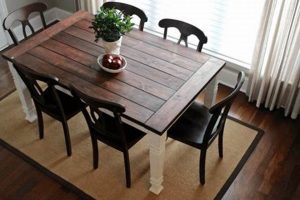
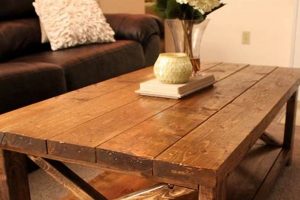
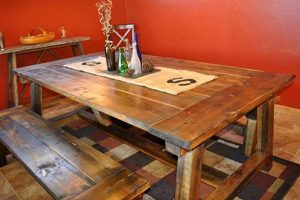
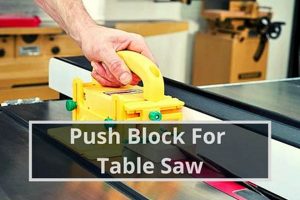
![Build a Safe DIY Table Saw Push Stick [Guide] The DIY Hub: Creative Crafts, Repairs & Life Hacks Build a Safe DIY Table Saw Push Stick [Guide] | The DIY Hub: Creative Crafts, Repairs & Life Hacks](https://craftingdiycenter.com/wp-content/uploads/2025/07/th-4323-300x200.jpg)
